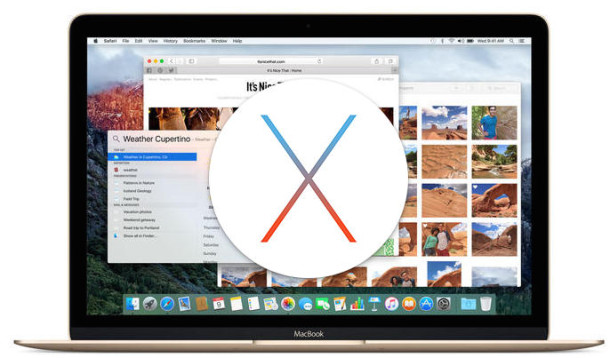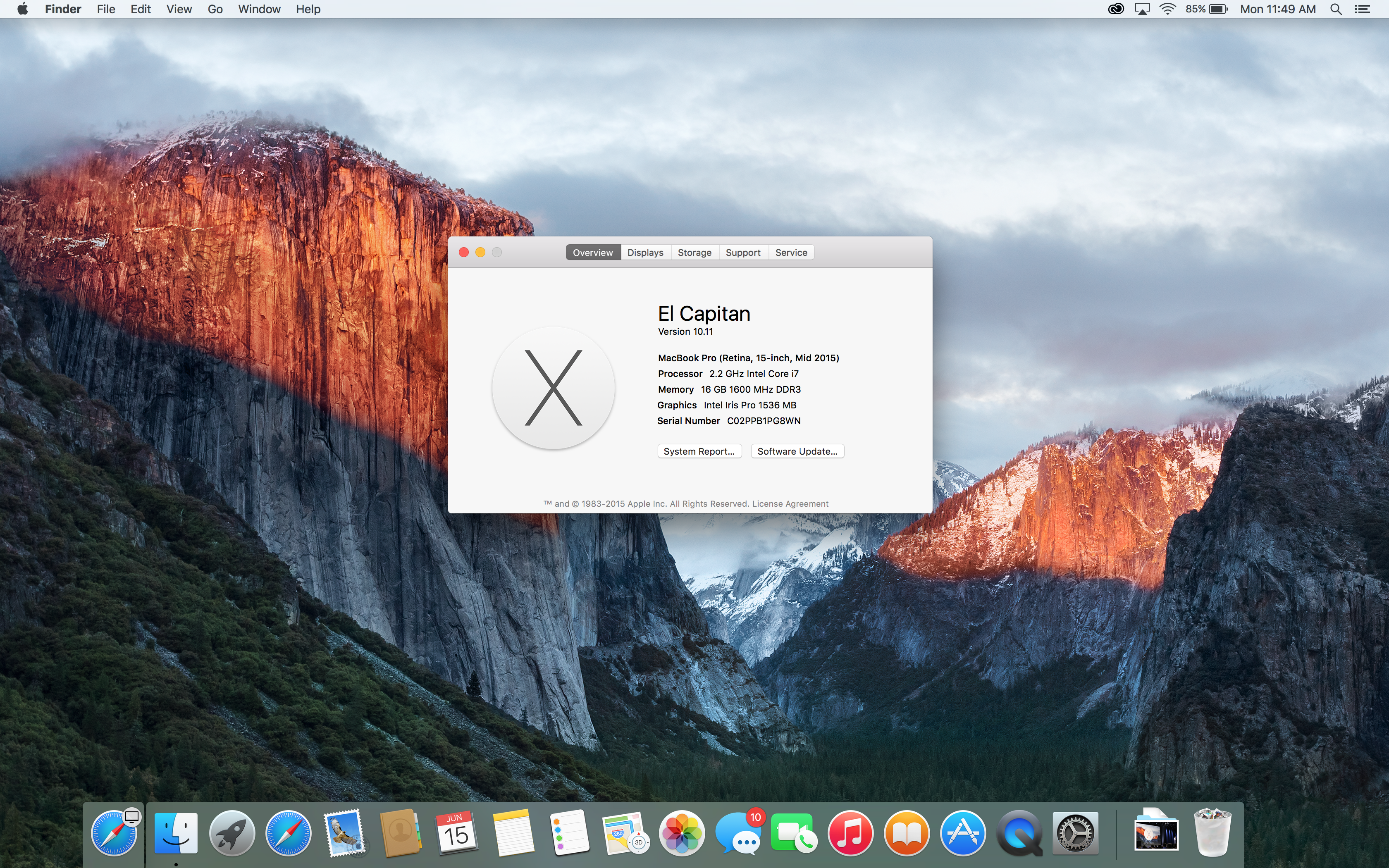Software Update El Capitan
Apple Metal updates. There is one more significant change coming to OS X El Capitan, Metal, the graphics technology that was announced with iOS 8. Metal will bring improved game performance. With yesterday’s software updates El Capitan fell off the security patch bandwagon, as expected. Apply historically only patches software for the current software plus two versions prior. So that means Mojave, High Sierra, and Sierra. The good news though, is that if you have a compatible computer software upgrades from Apple are free.
Computer mice all tackle the same computing chore (moving a pointer around the computer screen), but not all mice are created equal. You can update your mouse to one that has features you find useful and a look that you like.
1Decide whether you want a mouse with a USB or PS/2 connector.

Like keyboards, mice come with one of two connectors: USB (Universal Serial Bus) or PS/2. Since most desktop computers come with both of those ports, both types of mouse are compatible. PS/2 mice cost less and often come with an adapter that also lets the mice work in USB ports, if needed.
Or, if you’re short on USB ports, a PS/2 mouse lets you save those versatile USB ports for other gadgets. If you choose USB, however, you have a better selection of wireless mice. Plus, USB mice are hot swappable, meaning you can unplug them and plug them back in while your computer is running. PS/2 mice must remain plugged in at all times.
Jan 19, 2019 I connected the mouse/keyboard to the USB 2.0 ports on the top as seen in the pictures attached, which are next to the PS/2 ports. At the back there is 4x USB2.0 ports, and 2x USB3.x, 1 x FlashUSB. At the front i got 1 x USB2.0 and 1x USB 3.x. For software and drivers, select your product from the list below. Wireless Optical Mouse 2.0. Manuals Limited Warranty. Product Guide. Limited Warranty. Aug 29, 2016 My iMac 27' is a late 2013 model bought with wiresless keyboard and mouse and Trackpad, all have worked without fail until updating to OS X EI Capitan. Tags: none ( add ) el capitan problems with apple wireless keyboard. Aug 15, 2017 So basically I have a Mac Pro 2.1 8 core 32gb ram. I've spent months trying to upgrade to Yosemite using SFOTT and other various software to no avail. I gave in and bought one of those SSD's on eBay which have El Capitan pre installed especially for the old macs. I've plugged the new SSD.
2Figure out what features are worth your money.
A $10 mouse works fine for the basics. If you spend a little more, you can get an optical or touchpad mouse, a mouse that has a scroll wheel or trackball, or even a wireless mouse (just remember that wireless mice are battery hogs).
3If you’re installing a PS/2 mouse, turn off your computer. Be sure to exit any of your currently running programs, and then unplug your old mouse if it’s still plugged in.
Wireless Mouse Software Update For El Capitan 2


Examine where you currently plug in your mouse, and make sure your replacement uses the same type of plug, either USB or PS/2.
4Push the plug from the new mouse (or from the wireless mouse’s receiving unit) into the correct port on your computer.
USB plugs slide into USB ports pretty easily. If it’s not fitting, turn it over; the connector fits only one way. PS/2 connectors plug into the PS/2 port with a little mouse icon next to it. (The adjacent keyboard PS/2 port won’t work.) Make sure the notches and pins line up and push firmly until it’s all the way in.
5Add batteries to the wireless mouse, if necessary.
Some wireless mice include batteries in the box, but you need to actually put them in your mouse to get things started.
6Run the mouse’s installation program by inserting the CD that came with the mouse in your computer.
Scp containment breach codes. Windows usually provides a basic driver for your newly installed mouse, but the installation CD allows you to use the mouse’s fancier features.
7If the installation program doesn’t start automatically, browse the drive’s contents for a program named Setup and double-click that program icon to start things rolling.
Wireless Mouse Software Update For El Capitan Mac
Follow the prompts that appear to install your mouse’s software.
I just upgraded to OS X 10.11 on my latest gen iMac. I have a Microsoft Wireless Laser Mouse 5000, which has 5 buttons. I have the latest Microsoft Mouse driver software installed, 8.2. This is pretty old driver software actually, it hasn't been updated in years. Using the System Prefs> Configuration Panel I have always had buttons 4 and 5 set as 'Back' and 'Forward' respectively, allowing me to go back and forward on web pages. Up until 10.11, these buttons continued to work as they always had. But now, in El Capitan, they no longer function at all. I reinstalled the mouse 8.2 software, still no luck.
El Capitan Update Download

Apple's built-in mouse driver only allows for 2 buttons. I recognize that Microsoft should really update this driver software after all these years, but I'm guessing they won't for a while, if ever. Is there other mouse driver software for El Capitan that I can install to regain the use of my extra mouse buttons?
iMac, OS X El Capitan (10.11)
Wireless Mouse Software Update For El Capitan Version
Posted on
Performing an El Capitan-to-Sierra upgrade is easy. Although it does not come like a push-one-button-and-proceed method, the truth is it’s quite close.
Update To El Capitan
Requirements for Upgrading from El Capitan to Sierra
Before we proceed with our step-by-step guide, allow us to answer an important question that some Mac users have in mind: “Can an old Mac still upgrade to Sierra?”
The answer is, of course, a YES. However, there are a few minimum requirements that need to be met, such as the following:
- 2 GB RAM
- 8 GB Storage Space
- Mac Models: Late 2009 iMac, 2009 MacBook, 2010 MacBook Pro, 2010 MacBook Air, 2010 Mac Mini, 2010 Mac Pro
Once you are certain that your Mac has met the requirements above, make sure you have backed up your Mac. This backup will come in handy in case something comes up in the process of upgrading to High Sierra.
Pro Tip: Scan your Mac for performance issues, junk files, harmful apps, and security threats
that can cause system issues or slow performance.
Special offer. About Outbyte, uninstall instructions, EULA, Privacy Policy.
Upgrading from El Capitan to Sierra
After backing up your Mac’s important files and folders, it’s time to get started. Here’s how to upgrade from El Capitan to Sierra.
1. Download High Sierra from the App Store.
High Sierra is available for download from the App Store. To get it, follow these steps:
- Open the Mac App Store by simply clicking on the App Store icon in the dock.
- Navigate to the Featured tab.
- Find macOS Sierra in the rightmost column and click on it.
- Click Download.
- At this point, the download will start. It may take long, especially if it’s your first time accessing the App Store. Just be patient.
- Once the download is completed, the installer should launch automatically.
2. Start the Upgrade.
With the High Sierra installer ready, it’s time to actually install it. Here’s how:
- The High Sierra installer should now be open on your Mac. If you have accidentally quit it, you can restart it by going to the Applications folder and double-clicking on the installer.
- Click Continue to proceed.
- Press on the Agree button to agree with the software licensing terms and agreements flashed on your screen.
- Click on the Agree button again to verify your action.
- Hit Install.
- A new dialog box will pop up, requiring you to input your administrator password. Provide that information and click Add Helper.
- The High Sierra installer will begin copying the system files to the new target drive. The progress will show in a new window.
- As soon as all the system files are copied, your Mac will automatically reboot. Don’t panic if the restart process takes a while. It only means your Mac is coping with the installation process.
3. Utilize the Setup Assistant to Complete the Installation.
Your Mac should already be finished with the basic installation process. The next thing you should do is run the Setup Assistant to configure some important macOS High Sierra options and settings.
Take note, though, that if your Mac is configured to ask for your login details, a normal login window will show. Provide your login credentials so you can proceed with the following steps:

- The Setup Assistant starts off by asking you for your Apple ID details. If you wish to leave everything as it is, click the Set Up Later option.
- Let the Setup Assistant configure all vital services that need your Apple ID credentials. Simply provide your Apple ID password and hit Continue.
- Click Agree if you agree with the Terms and Conditions flashed on your screen.
- You will be asked to verify your action again. To continue, click Agree again.
- The Setup Assistant should then continue with configuring your iCloud account information. It will also ask you whether you want to set up iCloud Keychain. You can just skip it to avoid confusing yourself.
- Next, there will be options displayed on your screen regarding how you wish to use iCloud for storing images and documents. Choose which of them apply to you by clicking on the boxes next to each one of them:
- Store Files from Documents and Desktop in iCloud Drive – This option will allow you to automatically upload files from your Desktop and Documents folder to your iCloud Drive. Be mindful, though, that Apple only offers a limited amount of storage space for free users. If all this free space is exhausted, you will be asked to purchase additional storage.
- Store Photos and Videos in iCloud Photo Library – This will let you upload videos and images from your Photo Library to iCloud. As with the first option, you have to remember that you only have limited free storage space.
- Hit Continue.
- Wait for the Setup Assistant to finish the setup process.
- You will know when it’s done because you will be taken to your desktop.
Summary
How To Update Software From El Capitan To Sierra
We hope you found this guide useful. But before you download macOS Sierra and perform an upgrade, do not forget to clean up your Mac with a reliable Mac repair tool first. This way, you can ensure that nothing comes your way and keeps you from making the most of High Sierra.
Did we miss some important steps above? Do you know other, easier methods to upgrade from El Capitan from Sierra? We’d love to know. Comment on them below!